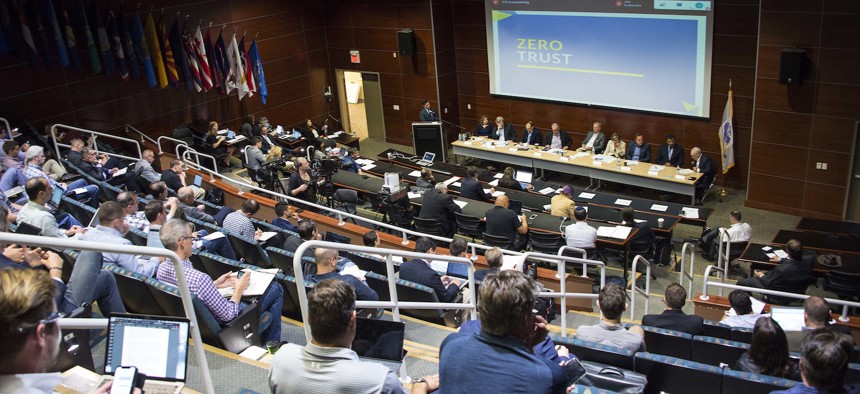The Pentagon’s innovation arm has a new chief and a new strategy
‘DIU 3.0,’ now under SecDef review, aims to embed teams in the combatant commands.
The Pentagon’s new innovation chief wants to redefine how the Defense Department adopts commercial technology, starting with extending the Defense Innovation Unit’s reach into the combatant commands.
“There was a time where, a bit, disruptors of the team was what was needed, because we just had to finally break through and change the way we were thinking about certain things,” said Doug Beck, the new director of the Defense Innovation Unit. “Now what we've got to do is we've got to be disruptors on the team, and that's about disruption at scale, which is more like the kind of world that I just came from. And that's why when I'm out here, I'm not wearing jeans. I'm wearing this thing,” the former Apple exec said, pointing to his tie.
The Defense Innovation Unit has long had engagement teams across the department, but now, the goal is to hit “a-whole-nother level,” Beck told reporters Tuesday at the National Defense Industrial Association’s emerging-tech event.
Instead of mere liaisons whose jobs were basically to “report on what’s going on today,” Beck said the new teams are meant to take on “an embed role that's about being part of the team to help solve the problem overall, help identify where the places are that commercial technology can make a difference and help identify which of those are the ones were the ones who should really help drive it for whether or maybe there's somebody else who want to and be part of that team in a embedded way.”
That cultural shift away from being “disruptors of the team” to “disruptors on the team” is something Beck, who is also a Navy Reserve captain, learned while working for Gen. Stan McChrystal, then-head of Joint Special Operations Command, in Iraq and Afghanistan.
The Defense Innovation Unit has been expanding its reach in recent years, turning nearly half of the prototypes it develops into products bought across the Defense Department. In 2022, DIU took 17 prototypes into purchasing, bringing its total to 52 over its eight years of existence.
Those numbers may seem small, especially when put up against a sprawling Pentagon budget that could hit $832 billion in 2024. But new leaders and a potentially billion-dollar budget have DIU poised for a new level of relevance.
Indo-Pacific Command is standing up a new directorate, led by a DIU team, and expanding DIU’s presence in Europe Command as an immediate priority amid Russia’s war on Ukraine, Beck said.
As a part of what is called the DIU 3.0 strategy, the agency has reorganized so that key pieces of the National Security Innovation Network, which helps funnel talent from universities and small companies to DOD, directly report to Beck. Cheryl Ingstad, who previously led NSIN, is now the deputy director of DIU for digital platforms and developer ecosystem. NSIN’s portfolios will be integrated alongside the other critical functions of DIU’s commercial operations.
Army Undersecretary Gabe Camarillo said he was looking forward to the next era of DIU, which he called adept at applying venture-capitalist practices to military problems.
“They have an understanding of what the VC market is investing in, they have an understanding of where emerging tech is going. And I think it would give us a really good opportunity to place a few bets in some areas that are really going to make a difference,” Camarillo said during a panel at the NDIA conference.
He said the service wants to expand on experiments like the 3D-printed barracks that the Army opened this year. (DIU is also behind projects like wearables that detect illness and fitting aircraft detection systems with AI.)
“I actually got to see the prototype and the applications of this are fascinating. The company's thinking about doing this on future manned missions to Mars, all the way to helping the Army today. But the technology is proven, it's real, we actually have some facilities that I think just opened up about two months ago. So it is an example where we can place some bets in some key technology areas with the U.S. partnership. And I look forward to expanding on that in the year to come.”
Navy Undersecretary Erik Raven said modeling the Marine Innovation Unit after DIU has transformed how the Navy does business and finds talent.
“If you look at how DIU has approached its way of tapping into expertise, innovation and talent, all across this country. There are great similarities and lessons learned that we are working to adapt into our own internal processes,” Raven said. “That same model of having experts leverage not only their professional expertise, but find those communities of interest where there's new solutions, new thinking, new innovations coming out. That is a business model that I think we can all adapt [to].”






